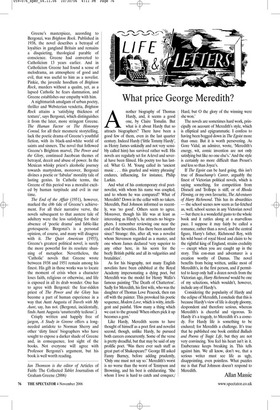Going back to the books
Ian Thomson
A STUDY IN GREENE by Bernard Bergonzi OUP, £16.99, pp. 208, ISBN 0199291020 With almost 30 novels to his name, Graham Greene was a prolific chronicler of human faith and wretchedness. A writer of his stature requires a very good biographer and, at first, it looked as though Greene had found him in Norman Sherry, a Joseph Conrad expert based in Texas. Sherry set to work in 1976, digging for information like a locker-room snoop. His first, 700-page volume up to 1939 scrutinised Greene’s every depression, love affair and alcoholic spree. ‘Oh why does Sherry waste so much time talking about me?’ Greene grumbled, though secretly, perhaps, he was amused by Sherry’s dedication to the task. He may even have enjoyed the vinous associations of his surname. (‘Let’s go to Sherry’s,’ by chance a gangster recommends a drinking club in Brighton Rock, adding, ‘I can’t stand the place’.) By the time Sherry’s third and final volume appeared in 2004, it was clear how ill-served Greene had been. Running to a combined total of almost 2,500 pages, Professor Sherry’s Life of Graham Greene consisted of vulgar hagiography as well as endless, dim critiques of the novels. Greene’s death, as described in the closing chapters, provoked the most awful writing:
Worms breed, and the handsome man with stunning blue eyes is host to a thousand sliding lascivious creatures, eating our flesh, turning us gradually into a sort of human jam. Why this passage, and others like it, were
allowed through is a mystery. Sherry’s impre cise use of language (‘sort of human jam’) was especially ill-suited to Greene, whose books are concisely written.
Bernard Bergonzi is another who finds Sherry (as he puts it) ‘tactless and indecorous’. While Bergonzi concedes that Sherry has something to say about Greene’s fiction and inner life, he ‘deplores’ Sherry’s readiness to conflate Greene with his fictional protagonists and projections. (‘Greene is Bendrix; Greene is Brown...’) A Study in Greene, however, is a work of elegant literary enquiry and intended in part as a riposte to Sherry. Greene’s personal life has been raked over enough, says Bergonzi; it is time to go back to the books. Greene’s masterpiece, according to Bergonzi, was Brighton Rock. Published in 1938, the novel describes a betrayal of loyalties in gangland Britain and remains a disquieting, theological parable of conscience. Greene had converted to Catholicism 13 years earlier. And in Catholicism Greene had found a sense of melodrama, an atmosphere of good and evil, that was useful to him as a novelist. Pinkie, the juvenile hoodlum of Brighton Rock, murders without a qualm, yet, as a lapsed Catholic he fears damnation, and Greene establishes our empathy with him.
A nightmarish amalgam of urban poetry, thriller and Websterian vendetta, Brighton Rock attains a ‘satisfying thickness of texture’, says Bergonzi, which distinguishes it from the later, more stringent Greene. The Human Factor or The Honorary Consul, for all their mesmeric storytelling, lack the poetic drama of Greene’s youthful fiction, with its black-and-white world of saints and sinners. The novel that followed Greene’s Brighton marvel, The Power and the Glory, continued Jacobean themes of betrayal, deceit and abuse of power. In the Mexican whisky priest’s alcoholic journey towards martyrdom, moreover, Bergonzi divines a poetic or ‘fabular’ morality tale of lasting genius. In Catholic terms, the Greene of this period was a moralist excited by human turpitude and evil in our time.
The End of the Affair (1951), however, marked the ebb tide of Greene’s achievement. For all their narrative verve, the novels subsequent to that austere tale of adultery were the less satisfying for their absence of ‘poetic drama’ and fable-like grotesquerie. Bergonzi’s is a personal opinion, of course, and many will disagree with it. The Quiet American (1955), Greene’s greatest political novel, is surely the more powerful for its resolute shunning of metaphor. Nevertheless, the ‘Catholic’ novels that Greene wrote between 1938 and 1951 remain among his finest. His gift in those works was to locate the moment of crisis when a character loses faith, religious or otherwise, and life is exposed in all its drab wonder. One has to agree with Bergonzi: the fear-ridden priest of The Power and the Glory has become a part of human experience in a way that Aunt Augusta of Travels with My Aunt, say, has not. (Bergonzi, incidentally, finds Aunt Augusta ‘unutterably tedious’.) Crisply written and happily free of jargon, A Study in Greene offers a longneeded antidote to Norman Sherry and other ‘dirty linen’ biographers who have sought to expose a darker shade of Greene and, in consequence, lost sight of the books. Not everyone will agree with Professor Bergonzi’s argument, but his book is well worth reading.
Ian Thomson is the editor of Articles of Faith: The Collected Tablet Journalism of Graham Greene (2006)



















































































































 Previous page
Previous page